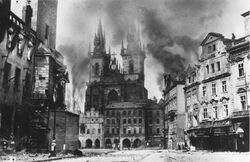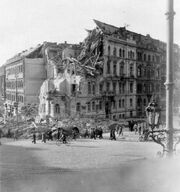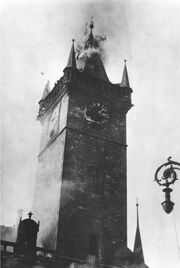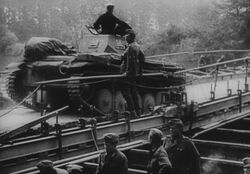| ||||||||||||||||||||||||||||
|
||||||||||||||||||||||||||||
The Siege of Prague in 1938 was fought between the Czechoslovak Army garrisoned and entrenched in the capital of Czechoslovakia (Prague) and the invading German Army.
It began with huge aerial bombardments initiated by the Luftwaffe starting on 1 October 1938 following the German invasion of Czechoslovakia. Land fighting started on 8 October, when the first German armored units reached the suburbs of the city. Despite German radio broadcasts claiming to have captured Prague, the initial enemy attack was repelled and soon afterwards Prague was placed under siege. The siege lasted until 21 October when the Czech garrison, officially capitulated. The following day approximately 80,000 Czechoslovak soldiers and troops left the city and were taken as prisoners of war. On 24 October the Wehrmacht entered Prague, which started a period of German occupation that lasted until 4 April 1945, when the city was liberated by the Allied forces.
During the siege around 18,000 civilians of Prague perished. As a result of the air bombardments 10% of the city's buildings were entirely destroyed and further 40% were heavily damaged.
Background
Prague was the capital and largest city of the Republic of Czechoslovakia. Situated on the River Vltava in central Bohemia, Prague had been the political, cultural, and economic centre of the Czech state for over 1100 years.
Prague was also one of the main industrial centres in Czechoslovakia, being the home of the ČKD (Českomoravská Kolben-Daněk), established in 1927. Being one of the major industrial centres, it was of equal strategic importance for both Germany and Czechoslovakia. In the orignial planning for Fall Grün, it was called for by the Luftwaffe not to attack the industrial centres of Czechoslovakia, as these plants would be vital for the German economy and war machine. Being the political centre of the whole republic, the Czechs had built several defensive lines of fortification around the town, in addition to the defensive line running along the German-Czech frontier in northern Bohemia.
In the days leading up to the beginning of the war, the city's people had prepared themselves for a possible German attack in many ways. Anti-Aircraft batteries had been positioned in and around the city, the city had performed several air raid and chemical air raid exercises, and bomb shelters had been built inside the city.
Opposing forces
Details of the siege
Heavy bombardments

Prague's Old Town Square (Staroměstské náměstí) burning after an air raid by the Luftwaffe.

Destruction in Prague caused by a Luftwaffe air raid.

The tower of the Old Town Hall on fire after an air raid by the Luftwaffe.
Due to poor weather conditions, Luftwaffe's aerial bombardment campaign could first begin around noon on the 30 September. Both the Luftwaffe's and the Czechoslovak air force's operations would be constrained throughout the campaign due to fog and mist. Despite the unpreferable weather conditions, the Luftwaffe would over the following weeks, apart from the military facilities such as infantry barracks and the Ruzyně airport, also target civilian facilities such as water works, railway stations, hospitals, market places and schools, which resulted in heavy human casualties that possibly led to the early surrender by lowering of morale of the Czechoslovak army defending the city.
Göring planned a major air attack on Prague on the first day of the war, but the attack was something of a shambles due to low-lying clouds. The four bomber groups (three from Kampfgeschwader 157 and the 1st Group from KG 254) that arrived over the city through the day were intercepted by the TOPL "A" (I./4th Squadron) and the Czechoslovak fighters shot down 14 aircraft with a loss of 10 Czech fighters and 13 damaged.
The anti-aircraft defence of the capital, designated OPL A (Obrany proti letadlům), was divided into fighter squadrons and anti-aircraft artillery. The former was the Ist Squadron/4th Regiment under Lieutenant Colonel Josef Hamšík and equipped with 33 Avia B-534 and the improved Bk-534 fighter aircraft. The latter comprised three OPL groups equipped with 24 pieces of 83.5 mm PLK vz. 22 and four 90 mm KPL vz. 12/20, two companies equipped with 20 mm VKPL vz. 36 light anti-aircraft guns, and five additional batteries of 80 mm PLK vz. 37 anti-aircraft guns (20 pieces in total), as well as an unknown number of other anti-aircraft machine guns. In total, the anti-aircraft defences of Prague had a total of 48 pieces of heavy anti-aircraft artillery. In addition to this, fire-fighter brigades and volunteers were supervised by Petr Zenkl, the mayor of Prague.
Initially the air defence of Prague was fairly successful and by 6 October 1939 the Ist Squadron/4th Regiment had managed to shoot down 48 enemy aircraft, while anti-aircraft artillery had shot down a similar number of enemy bombers. In addition, there were also 9 unconfirmed victories and 20 damaged enemy planes. However, the squadron also suffered heavy losses, and by 7 October it had lost over 23 pieces of equipment, or approximately 70% of its initial strength, which greatly contributed to an early surrender. They were reinforced by 11 aircraft of the 46th and 47th Flights, but by 11 October the air defences in Prague only had 5 operational fighters left. By then the anti-aircraft artillery had also started to crumble due to a lack of ammunition. Furthermore, as the war progressed, the German high command redirected more bombers to attack the city, including the historical old town and other iconic monuments, significant to the Czech nation and its capital. At the peak of the initial bombing campaign on 16 October, there were more than 50 German bombers above Warsaw. During that day, nicknamed "Bloody Sunday", there were 13 consecutive bombing raids.
Eve of the battle
On 2 October the forces of the German XVI Army Corps under Lieutenant General Heinz Guderian managed to break through the fortified positions of the Czechoslovak First Army near Plzeň and started their march towards the river Vltava and Prague. As the 1st Fast Division launched a counterattack near Hořovice to delay the German advance, Linhart ordered his men to prepare for the defence of Prague and asked in his daily radio releases all civilians to construct barricades and anti-tank barriers on the streets and at the outskirts of Warsaw.
Considering General Linhart, commanding the Border Zone XI (Hraniční pásmo XI) were only to hold the capital long enough to allow the rest of the army to withdraw towards Slovakia, he had substantial forces under his command. He had 22 battalions of infantry, three regiments and two detachments of artillery, with a total of 81 guns and howitzers. The District Headquarters of Prague (Velitelství okrsku Praha, VOP), commanded by Brig.Gen. Cyril Langer, was responsible for the defence of the fortified Prague Line (Pražské čáry) running from Mělníka on the Labe River in the north and Slap on the Vltava River to the south, and had 24 anti-tank guns at his disposal. In reserve the 18th Division (commanded by Brig.Gen. Miloslav Fassati), deployed in the Kladno area, had a strength of 11,315 men, 30 howitzers, 10 anti-tank guns and 3 LT vz. 34 light tanks.
To coordinate civilian efforts and counter the panic that started in Prague, Linhart appointed the Mayor of Prague Petr Zenkl as the Civilian Commissar of Prague. Zenkl started to organize police and fire fighters. He also ordered all members of the city's administration to retake their posts. In his daily radio releases he asked all civilians to construct barricades and anti-tank barriers on the streets and at the outskirts of Prague. On October 6 the Skupina 1 (commanded by Brig.Gen. Václav Petřík) – withdrawing from the forward fortified positions in northwestern Bohemia and equipped with 72 anti-tank guns and three LT vz. 34 tanks – took up positions behind the Prague Line.
Battle of the Prague Line

A Pz.Kpfw. II of the 1st Panzer Division crosses a pontoon bridge over the Berounka River near Beroun, 20 kilometres from Prague, on the 7 October 1938.
Initial clashes
Siege of Prague
Capitulation and surrender
General Linhart had managed to gather enough war materials to successfully defend the city for another week. However, the situation of the civilian inhabitants of Prague became increasingly tragic. Constant bombardment of civilian facilities, lack of food and medical supplies resulted in heavy casualties among the city's population.
The water works were destroyed by German bombers and all boroughs of Prague experienced a lack of both potable water and water with which to extinguish the fires caused by the constant bombardment. Also, the strategic situation became very difficult. The prospect of further civilian casualties and destruction, Hungary's entry into the war and the lack of support from the Western Allies made the defence of the city pointless and heavily demotivated the volunteers in participating in any further military actions.
On 20 October, General Cyril Langer, started capitulation talks with the German commander. On 21 October, at 12:00 a cease fire agreement was signed and all fighting halted. Soon afterwards, Prague capitulated. Several units declined to put down their weapons and cease fire, and their commanding officers had to be visited by generals Linhart and Langer personally.
On September 29, the garrison of Warsaw started to hide or destroy their heavy armament. Some of the hidden war material was later used during the Warsaw Uprising. On 23 October, the evacuation of Czechoslovak forces to German prisoner of war camps started and, the following day, German units entered the capital.

